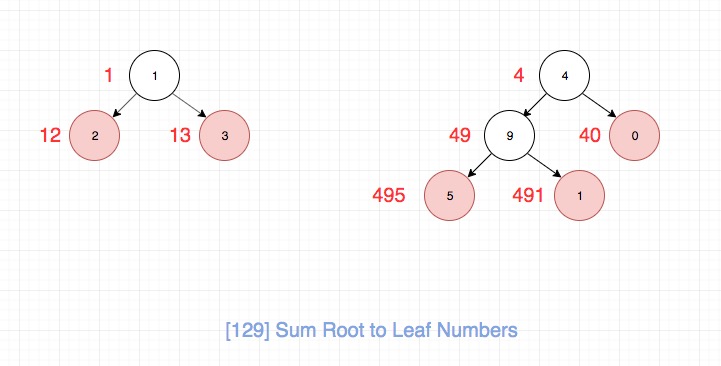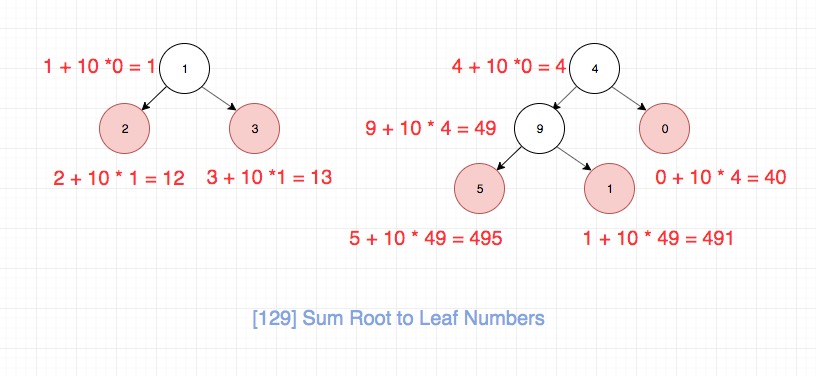6.3 KiB
6.3 KiB
题目地址
https://leetcode.com/problems/sum-root-to-leaf-numbers/description/
题目描述
Given a binary tree containing digits from 0-9 only, each root-to-leaf path could represent a number.
An example is the root-to-leaf path 1->2->3 which represents the number 123.
Find the total sum of all root-to-leaf numbers.
Note: A leaf is a node with no children.
Example:
Input: [1,2,3]
1
/ \
2 3
Output: 25
Explanation:
The root-to-leaf path 1->2 represents the number 12.
The root-to-leaf path 1->3 represents the number 13.
Therefore, sum = 12 + 13 = 25.
Example 2:
Input: [4,9,0,5,1]
4
/ \
9 0
/ \
5 1
Output: 1026
Explanation:
The root-to-leaf path 4->9->5 represents the number 495.
The root-to-leaf path 4->9->1 represents the number 491.
The root-to-leaf path 4->0 represents the number 40.
Therefore, sum = 495 + 491 + 40 = 1026.
思路
这是一道非常适合训练递归的题目。虽然题目不难,但是要想一次写正确,并且代码要足够优雅却不是很容易。
这里我们的思路是定一个递归的helper函数,用来帮助我们完成递归操作。 递归函数的功能是将它的左右子树相加,注意这里不包括这个节点本身,否则会多加, 我们其实关注的就是叶子节点的值,然后通过层层回溯到root,返回即可。
整个过程如图所示:
那么数字具体的计算逻辑,如图所示,相信大家通过这个不难发现规律:
关键点解析
- 递归分析
代码
- 语言支持:JS,C++,Python
JavaScipt Code:
/*
* @lc app=leetcode id=129 lang=javascript
*
* [129] Sum Root to Leaf Numbers
*/
function helper(node, cur) {
if (node === null) return 0;
const next = node.val + cur * 10;
if (node.left === null && node.right === null) return next;
const l = helper(node.left, next);
const r = helper(node.right, next);
return l + r;
}
/**
* Definition for a binary tree node.
* function TreeNode(val) {
* this.val = val;
* this.left = this.right = null;
* }
*/
/**
* @param {TreeNode} root
* @return {number}
*/
var sumNumbers = function(root) {
// tag: `tree` `dfs` `math`
return helper(root, 0);
};
C++ Code:
/**
* Definition for a binary tree node.
* struct TreeNode {
* int val;
* TreeNode *left;
* TreeNode *right;
* TreeNode(int x) : val(x), left(NULL), right(NULL) {}
* };
*/
class Solution {
public:
int sumNumbers(TreeNode* root) {
return helper(root, 0);
}
private:
int helper(const TreeNode* root, int val) {
if (root == nullptr) return 0;
auto ret = root->val + val * 10;
if (root->left == nullptr && root->right == nullptr)
return ret;
auto l = helper(root->left, ret);
auto r = helper(root->right, ret);
return l + r;
}
};
Python Code:
# class TreeNode:
# def __init__(self, x):
# self.val = x
# self.left = None
# self.right = None
class Solution:
def sumNumbers(self, root: TreeNode) -> int:
def helper(node, cur_val):
if not node: return 0
next_val = cur_val * 10 + node.val
if not (node.left or node.right):
return next_val
left_val = helper(node.left, next_val)
right_val = helper(node.right, next_val)
return left_val + right_val
return helper(root, 0)
拓展
通常来说,可以利用队列、栈等数据结构将递归算法转为递推算法。
描述
使用两个队列:
- 当前和队列:保存上一层每个结点的当前和(比如49和40)
- 结点队列:保存当前层所有的非空结点
每次循环按层处理结点队列。处理步骤:
- 从结点队列取出一个结点
- 从当前和队列将上一层对应的当前和取出来
- 若左子树非空,则将该值乘以10加上左子树的值,并添加到当前和队列中
- 若右子树非空,则将该值乘以10加上右子树的值,并添加到当前和队列中
- 若左右子树均为空时,将该节点的当前和加到返回值中
实现
- 语言支持:C++,Python
C++ Code:
class Solution {
public:
int sumNumbers(TreeNode* root) {
if (root == nullptr) return 0;
auto ret = 0;
auto runningSum = vector<int>{root->val};
auto queue = vector<const TreeNode*>{root};
while (!queue.empty()) {
auto sz = queue.size();
for (auto i = 0; i < sz; ++i) {
auto n = queue.front();
queue.erase(queue.begin());
auto tmp = runningSum.front();
runningSum.erase(runningSum.begin());
if (n->left != nullptr) {
runningSum.push_back(tmp * 10 + n->left->val);
queue.push_back(n->left);
}
if (n->right != nullptr) {
runningSum.push_back(tmp * 10 + n->right->val);
queue.push_back(n->right);
}
if (n->left == nullptr && n->right == nullptr) {
ret += tmp;
}
}
}
return ret;
}
};
Python Code:
class Solution:
def sumNumbers(self, root: TreeNode) -> int:
if not root: return 0
result = 0
node_queue, sum_queue = [root], [root.val]
while node_queue:
for i in node_queue:
cur_node = node_queue.pop(0)
cur_val = sum_queue.pop(0)
if cur_node.left:
node_queue.append(cur_node.left)
sum_queue.append(cur_val * 10 + cur_node.left.val)
if cur_node.right:
node_queue.append(cur_node.right)
sum_queue.append(cur_val * 10 + cur_node.right.val)
if not (cur_node.left or cur_node.right):
result += cur_val
return result
相关题目
这道题和本题太像了,跟一道题没啥区别

